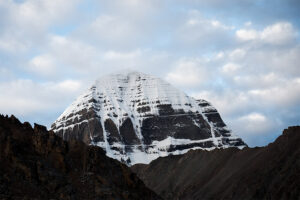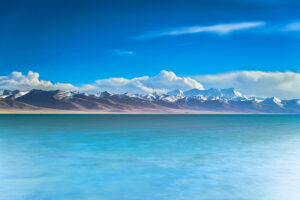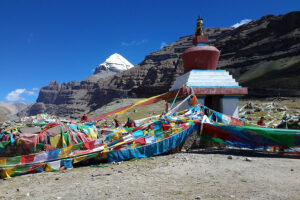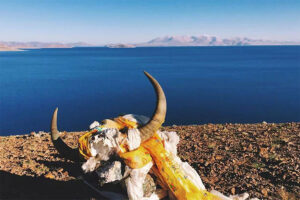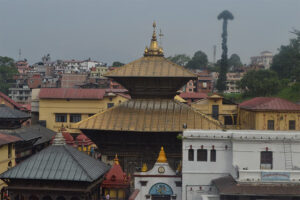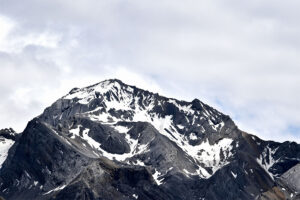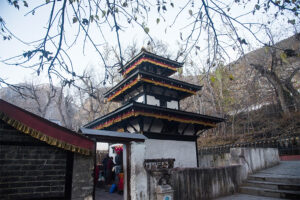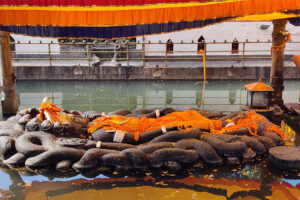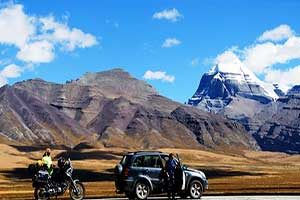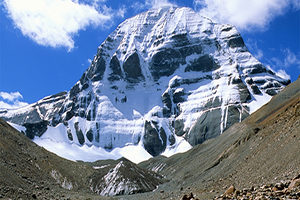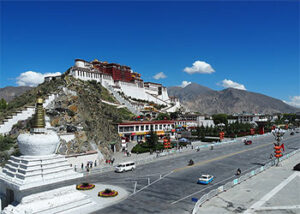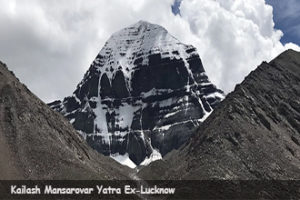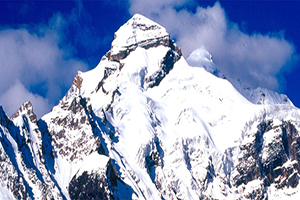Mount Kailash
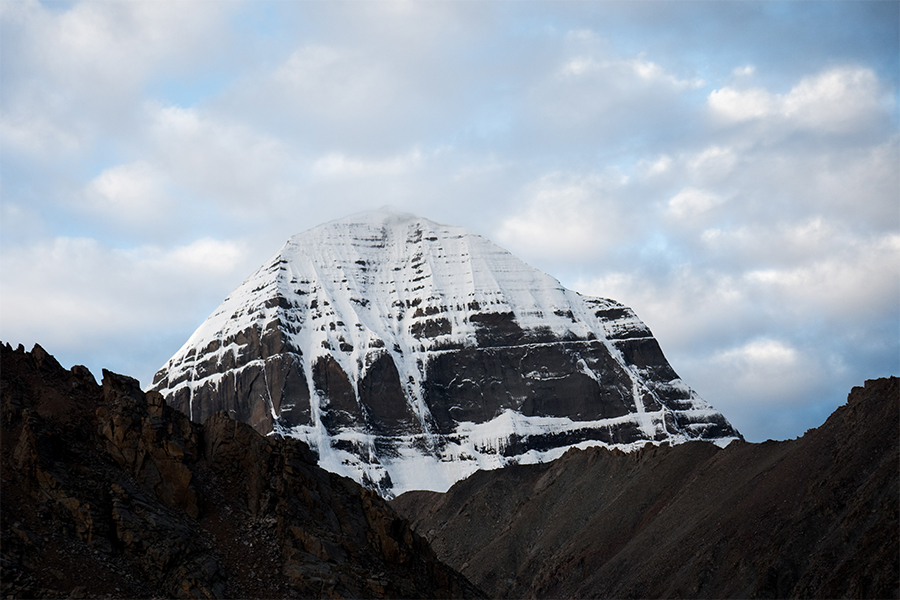
If there is one mountain that can be called the original and true abode of Lord Shiva, it is Mount Kailash. You will not find any mountain on earth that is as sacred and so mysterious as Mount Kailash. There are so many mysteries that surround Mount Kailash that it has made it more intriguing than most other mountains on earth. One such fact is that no one has ever climbed Mount Kailash. Such mysteries overwhelm you and even make you wonder about this magnificent mountain.
However, Kailash Mansarovar Yatra has made it possible for devotees and tourists to reach this holy mountain. Kailash Mansarovar Yatra is one of the holiest and epic pilgrimages in the world. Millions of people brave the toughest climatic conditions to reach Mount Kailash during Kailash Mansarovar Yatra. They trek long distances on foot and endure the biting cold of the Tibetan Himalayas to get close to Mount Kailash. Mount Kailash is the ultimate trekking destination and also one of the immensely religious and spiritual places that you can visit on earth.
The Geographical Location of Mount Kailash
Mount Kailash is situated in the Tibetan region of China. Its exact location is in the Kailash Range and the western region of the Tibetan Plateau. Mount Kailash lies 100 km to the north of the point where the western borders of Nepal, India, and China meet. Mount Kailash is part of the Himalayan mountain range known as the Trans-Himalayan Mountains. Mansarovar and Rakshas Tal are two alpine lakes near Mount Kailash. The region around Mount Kailash is the source of the greatest rivers in Asia. These rivers are Indus, Brahmaputra, Sutlej, and Karnali.
Mythological Significance of Mount Kailash to the Hindus
Among all the mountains in the world, there is no mountain that is as sacred as Mount Kailash. For Hindus, Mount Kailash is the abode of Lord Shiva and Goddess Parvati. The oldest Hindu scriptures like Upanishads, Vedas, and Puranas mention Mount Kailash as the home of Lord Shiva. This is the mountain on top of which Lord Shiva sits in meditation. Mount Kailash is the link between the heavens and the earth. Mount Kailash is also called Om Parvat. This is because the snow that falls on Mount Kailash takes the shape of the letter ‘Om’ which is very sacred and auspicious to the Hindus. Even the shadow of the mountain falls in the shape of the Swastik sign, which is a symbol of prosperity, wealth, and well-being.
The Religious Significance of Mount Kailash for the Jains
For the Jain religion, Mount Kailash is the mountain where Rishabhadeva, the first Jain Tirthankara attained Nirvana or moksha (liberation from the cycle of life and death). It is also very interesting to know that the last Tirthankara of the Jain religion, Vardhamana Mahavira visited Mount Kailash when he was a child. Lord Indra put his mother into a deep slumber and took Vardhamana Mahavira to the top of Mount Kailash, where he was bathed with ceremonial rituals.
The Spiritual Importance of Mount Kailash in Buddhist Cosmology
Buddhists consider Mount Kailash as Mount Meru. Mount Meru is the most sacred mountain and is the center of the universe for Buddhists. Followers of Vajrayana Buddhism have tremendous respect and devotion to Mount Kailash. It is said that Milarepa, one of the greatest Tibetan masters, was the only one who could climb Mount Kailash. He could do so because of his immensely powerful Tantrik powers and spiritual practices. For Buddhists, Mount Kailash is where you would find supreme bliss and joy.
The Four Faces of Mount Kailash
You can have beautiful views of all four sides or faces of Mount Kailash by taking the Kailash Mansarovar Parikrama. These four faces of Mount Kailash are equally scenic.
- South Face: The South Face of Mount Kailash looks like a spine. The South Face of Mount Kailash starts to appear gradually as you reach Yam Dwar. The South Face of Mount Kailash is the backside of the mountain.
- North Face: The North Face of Mount Kailash is the most famous one. Tourists recognize Mount Kailash through North Face. During Kailash Mansarovar Parikrama, when you reach Dirapuk Monastery, you can see the North Face.
- East Face: You can see the East Face of Mount Kailash during your Inner Kora. The Inner Kora is a parikrama of Mount Kailash that is 34 km long. It is done at the foothills of Mount Kailash. You can see the Eastern Face of Mount Kailash as you reach Gauri Kund. When you start your trek from Dirupuk towards Dolma La Pass and make your way to Gauri Kund, you will see this East Face.
- West Face: The West Face of Mount Kailash can be seen when you start your trek from Yam Dwar. You can make some halts during this trek and observe this West Face closely. Many travelers have also had the experience of seeing a face on the West Face of Mount Kailash.
Mount Kailash Parikrama
Going around Mount Kailash is called a Parikrama. A Parikrama of Mount Kailash is a circumambulation of Mount Kailash. Mount Kailash Parikrama is of two types – Inner Kora and Outer Kora.
Mount Kailash Inner Kora
The Inner Kora is a trekking route around the base of Mount Kailash. The Inner Kora trek starts from Darchen. The Mount Kailash Inner Kora Yatra is 34 km long and is tougher than the Mount Kailash Outer Kora Yatra. Those who cannot walk on foot during this Parikrama can take the pony or yak rides. Due to crevices, and tough mountain terrain, tourists should have some trekking or mountaineering experience. The ice and snow here can make trekking difficult. But there are so many places that you can visit on this Kailash Inner Kora Yatra. The major ones are Nandi Parbat, Saptrishi Caves, Ashtapad, Atmalingam, and Kuber Kund. Tourists who are fit for trekking can do this Inner Kora in a day. But nowadays, it is very common for tourists to take two days.
Places to Visit on the Inner Kora Parikrama Route
- Yam Dwar: The actual Inner Kora of Mount Kailash starts from Yam Dwar. Yam Dwar means Gates of Death. Every tourist has to cross Yam Dwar before the Inner Kora trek. Tibetan tie prayer flags here as a ceremonial ritual.
- Nandi Parbat: Nandi Parbat is named as it resembles the shape of Nandi, the sacred bull of Lord Shiva.
- Saptrishi Caves: These are naturally formed caves that are named after seven sages. These sages or ‘rishis’ were devotees of Lord Shiva. These caves have 13 Buddhist shrines in them. Saptrishi Caves offers very good views of Nandi Parbat.
- Ashtapad: Ashtapad is a mountain near Nandi Parbat. The name translates to Eight Steps’. Ashtapad is a cave where sages have meditated for many centuries.
- Atmalingam: Atmalingam is at the base of Mount Kailash. This is a cluster of caves where sages and mystics meditated.
- Kuber Kund: This is a very sacred place on the Inner Kora trekking route.
Important Legs in Mount Kailash Inner Kora
The Inner Kora has three stages or legs, and these three are very important to take if you want to have the best experience of the Kailash Mansarovar Yatra.
- Charan Sparsh from Dirapuk (6 km trek)
- Trek from Shivasthal to Kuber Kund and Zuthulpuk (18 km trek)
- Nandi Kora (Trekking from Darchen to Nandi Parvat, Ashtapad, Atma linga, and Saptrishi Caves)
Mount Kailash Outer Kora
The Mount Kailash Outer Kora trek is longer than the Inner Kora trek. The trek route of Outer Kora is 56 km. There are more monasteries on this Outer Kora trek. The Mount Kailash Outer Kora trek also starts from Darchen. It generally takes 3 days to complete the Outer Kora trek. Tourists stay in Dirapuk and Zuthulpuk during this trek. However, pilgrims are seen taking longer than 3 days to complete the Outer Kora. It may take 3 to 4 weeks because pilgrims who have tremendous devotion lie flat on the ground several times during this Outer Kora trekking.
Places to Visit on the Outer Kora Parikrama Route
- Sarchung Valley
- Lha Chu Valley
- Chuku Monastery
- Dirapuk Monastery
- Dolma-la Pass
- Gaurikund Lake
- Lam Chu Valley
- Zuthulpuk Monastery
- Dzing Chu Valley
Religious Places Near Mount Kailash
- Lake Mansarovar: It is a freshwater lake situated near Mount Kailash. The glacial waters of Kailash Glaciers feed the lake. According to Hindus, Mansarovar Lake was formed out of the mind of Lord Brahma. Mansarovar Lake is one of the highest freshwater lakes in Asia. Lake Mansarovar is the source of the Sutlej River. The lake is thought to be the home of the celestial bird of Brahma, the Swan, or Hamsa. Tourists consider it very holy to bathe in this lake and drink water from it.
- Rakshastal: Rakshastal is a lake near Mansarovar Lake. Rakshastal Lake is named after the mythical demon of Hindu mythology called Ravana. It is said that Ravana was a devoted follower of Lord Shiva and meditated for many centuries at the place which is now Rakshastal Lake. The waters of the lake are salty and not fit for drinking or bathing.
- Yam Dwar: Yam Dwar is the actual place from where the Parikrama of Mount Kailash starts. Yam Dwar means the ‘Gate of Yam’. Yam is the Hindu god of death. Tibetans call this place Tarboche.
- Gauri Kund: Gauri Kund is a small lake that comes when you come from Dolma-La Pass. Hindus also call Gauri Kund by the name of Parvati Sarovar. It is here that Goddess Parvati created Lord Ganesha.
- Ashtapad: Ashtapad is a very holy place near Mount Kailash. In Jain mythology, Rishabhdev, the first Tirthankara, attained nirvana here at Ashtapad. Even Tibetans view Ashtapad as a very holy and spiritual place.
- Dirapuk Monastery: You can see the north face of Mount Kailash clearly from Dhirapuk Monastery. This is a 13th-century monastery founded by Yogin Gotsangpa (a Tibetan disciple of Milarepa). The monastery is near a cave. On the first day of your Mount Kailash Kora, you will arrive at this monastery.
- Serlung Gompa: It is the first monastery that comes on the Inner Kora circuit. Dordzin Konchok Gyudzin built this monastery.
- Milarepa’s Cave: Milarepa Cave is named after a Tibetan mystic called Milarepa. It is said that Milarepa meditated in these caves for centuries. Milarepa is also the only person who climbed Mount Kailash.
- Zuthulpuk Monastery: Zuthulpuk Monastery is also a 13th-century Tibetan monastery. The monastery is on the east side of Mount Kailash. This monastery is the last monastery that comes on Mount Kailash Parikrama.
- Shivasthal: This is a place that symbolizes death and life. Pilgrims on Kailash Mansarovar Yatra put a piece of clothing here as a symbol of leaving their past lives behind. You can see prayer flags at this place. You can go trekking to Kuber Kund from Shivasthal.
- Dolma-la Pass: Dolma-la Pass is one of the highest mountain passes near Mount Kailash. You will find this place covered with prayer flags. Crossing Dolma-la Pass is the toughest part of the Kailash Mansarovar Yatra. You can view Gauri Kund at the point when Dolma-la Pass ends.
Best Route from India to Mount Kailash
Via Lipulekh Pass: This route passes through Uttarakhand. This route is very long and takes around 24 days. There is a road till Tawaghat. From there you have to trek up to Lipu Pass which is on Indo-Tibetan Border. You will have to trek 15 to 18 km a day on this route. The trek route in India goes through Johar Valley, Narayan Ashram, Patal Bhuvaneshwar, and other places in Kumaon Himalayas in Uttarakhand.
Via Nathu La Pass: Nathu La Pass is in Sikkim. The Nathu La Pass route is longer but is more convenient because there is less trekking involved here. Most of the route that lies in India is motorable. You can take a flight from Delhi to Bagdogra Airport or Siliguri Airport. From Siliguri, you can take a cab and drive on the road. The route is very scenic and goes through beautiful places like Hangu Lake, places on the Tibetan Plateau. The route takes 21 days.
Other Routes to Reach Mount Kailash
Other routes go through Nepal and Lhasa. Indians do not generally take these routes. Chinese or International travelers generally take this route.
Why is it Difficult to Reach Mount Kailash?
Mount Kailash is located in a very high-altitude region of Tibet. There are high Himalayan mountains everywhere and oxygen levels can be very low. Climate is generally cold and dry. Tourists need to acclimatize themselves to the climatic conditions here. They need to be very fit to trek through the snowy and rocky terrain here.
What is the Best Time and Season to Visit Mount Kailash?
The months from middle of May to October are best time to visit Mount Kailash.
Can I climb Mount Kailash?
Mount Kailash is one of the most sacred mountains on earth. It has not been climbed by anyone until yet. Climbing is forbidden for tourists.
What is the Height of Mount Kailash?
Mount Kailash is situated high in the Tibetan Plateau of China. Mount Kailash is situated at an altitude of 6,714 m (22,028 ft) above sea level.
Will I require a passport to visit Mount Kailash?
Yes. You will require a valid passport to reach Mount Kailash.
Things to do Near Mount Kailash
- Inner/ Outer Kora (Parikrama) of Mount Kailash
- Visit various Tibetan monasteries
- Holy dip in Mansarovar Lake
- Charan Sparsh of Mount Kailash
- Yak rides or pony rides
- Explore the caves
- Trekking/ hiking
- Stargazing
How Should I Prepare for the Mount Kailash Tour?
- Practice eating vegetarian food and take more liquids.
- Do regular exercises like jogging, cardio workouts, climbing a mountain, Yoga, and Prayanam, mental strength exercises.
- Try to acclimatize before the Mount Kailash Parikrama begins.
- Try to protect yourself from altitude sickness.
- Stay aware of signs like dizziness, headaches, weakness, fatigue, vomiting, nausea, breathlessness, and loss of appetite.
- Stay with people and other tourists and don’t wander off the trekking trail.
- Avoid exertion and stay on your trip itinerary.
Food that is Available on a Tour of Mount Kailash?
Vegetarian food is generally available on Kailash Mansarovar Yatra. Food like Pasta, noodles, rice, tea, coffee, roti, fresh fruits, vegetables, ready to make soups, are served to tourists.
Accommodation on Mount Kailash tour
Tour operators generally reserve hotel rooms in cities during the Kailash Mansarovar Yatra tour.
- Hiking/ Trekking shoes
- 50 to 80 liter backpack
- Pairs of socks, underwear, hiking pants, pajamas, t-shirts
- Thermal jackets, woolen sweaters, hooded jackets
- Hats, gloves, scarves, winter coats
- Towel, fleece tops, sports bra
- Toiletries, medical kit, medicines, first aid kit
- Sleeping bags, thermos, trekking poles
- Laundry bag
- Batteries, flashlight, memory cards, iPad, Kindle
- Camera, travel adapters
- Ready-to-eat food, protein bars, dry fruits, chocolates, snacks
- Notebook, pen, digital compass, guidebooks, physical maps
- Water bottles, juice, energy drinks, empty bottles
Which Age Groups are Allowed to Visit Mount Kailash?
Persons who are 18 years and above, and below 70 years are allowed to go on Mount Kailash Yatra.
Who should not go to Mount Kailash?
Persons who have high blood pressure, diabetes, asthma, mental health problems, weak should not go to Mount Kailash. People should take medical tests and should be within 18 – 70 years to be able to go to Mount Kailash Yatra.
